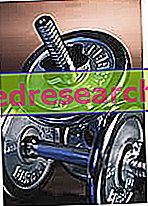The adenoids or pharyngeal tonsils are lymphoid masses that lie behind the nasopharynx (in other words, behind the nose).
They play a predominantly defensive role and block most of the atmospheric microorganisms, so that they do not pass into the respiratory tract.

The pathologies affecting this district may be occasional, recurrent, acute or chronic.
Infected / inflamed adenoids swell making nasal ventilation difficult.
The most common diseases of adenoids are:
- Infection: infectious adenoiditis from bacteria, viruses or fungi.
- Hypertrophy: adenoids permanently enlarged due to recurrent infections or allergic reactions.
There are also discomforts to the hereditary / anatomical type of adenoids (sometimes hypertrophy starts already inside the mother's womb).
What to do
- In the presence of specific symptoms, it is necessary to contact the primary care physician or directly to the otolaryngologist specialist.
The typical symptoms of enlarged adenoids are:
- For acute infectious adenoiditis: fever and rhinorrhea with serous or mucus-purulent nasal discharge. Sometimes, also rhinitis, otitis and sinusitis are associated.
- Snoring: snoring is typical of diseases that characterize the upper respiratory tract (rhinitis, pharyngitis, sinusitis, etc.), but in the case of hypertrophic adenoids it is permanent.
- Sleep apnea: ventilation pauses during sleep.
- Daytime sleepiness: typical of sleep disorders. It is no coincidence that adenoids are among the causes of Obstructive Sleep Apnea Syndrome - OSAS.
- Open mouth breathing: since nasal ventilation is physically impeded, the subject reacts spontaneously by opening the pharynx.
- Nasal voice: caused by reduced communication between the nose and pharynx.
- The doubt must increase in the event that some complications such as:
- Recurrent catarrhal otitis: caused by tubal occlusion; they often cause perforation of the eardrum, with leakage of fluid from the ear.
- Relapsing fever: caused by frequent infections, especially in the winter months.
- Alteration of the palatine structure and dental malocclusion: caused by the respiratory alteration.
- In children, lack of appetite.
- With a diagnosis of adenoiditis, it is necessary to adopt a series of measures:
- Blow your nose frequently.
- Clean the inside of the nose with physiological solution to be instilled several times a day. It is especially useful in small children who cannot blow it.
- Assume a slightly inclined position, with the head raised, to favor night breathing. The use of a pillow under the mattress at head height may be useful.
- Keep yourself hydrated, to keep any nasal secretions fluid and more easily eliminated.
- Use night humidifiers in dry environments.
- Make aerosol with saline solution or Sirmione water waiting for a therapy.
- To children (preschool age):
- Facilitate feeding: see What to Eat below.
- Nocturnal observation: it is necessary to establish the severity of the disorder (presence of apneas, duration, etc.).
- Drug therapy: varies according to age; the little ones do not tolerate the same drugs to be given to adults. Generally, it consists of: anti-inflammatories and / or antibiotics and / or antifungal agents / or antihistamines. For viral infections remission is usually spontaneous and occurs in approximately 48 hours.
- If drug therapy fails, a microbiological culture may be needed to identify a specific drug. The bacteria most often involved are: streptococci, moraxella and staphylococci.
- Surgery: to be exploited only when drug therapy is not conclusive. In children who are frankly affected by an adenoid disease, some specialists recommend operating before school age (in order to avoid complications in learning and developing language).
- Post-surgical rest: to prevent bleeding and / or infections. It lasts at least 7-14 days. The subject can drink fluids almost immediately and is free to counteract the pain by using certain medications.
What NOT to do
- Do not seek medical attention, especially if the infections are recurrent and close together, or if symptoms of nasal hypertrophy / obstruction become important.
- For parents, do not carefully observe the clinical signs of the child or do not inform the pediatrician.
- Leave the nose covered with mucus.
- Sleep in positions that hinder ventilation.
- Neglecting hydration: in this way the mucus becomes more difficult to expel.
- Sleep in environments with too dry air (for example in rooms with stove or fireplace) or too wet.
- To children (preschool age): propose very hot and hardly chewable food.
- Do not respect drug therapy.
- For those who suffer from allergies: expose themselves to allergens or do not prevent allergic crises.
- If the disorder continues to occur several times a year, do not go into the diagnosis.
- Exclude surgery even if necessary.
- Do not respect post-surgical rest
What to eat
There is no special diet to cure adenoid diseases, but by respecting the following principles it is possible to optimize therapy:
- Easy chewing and swallowing (especially for children): without using a nose it is impossible to chew and breathe simultaneously. This requires foods that should not remain in the mouth for long. It is advisable to eat easily chewable foods, better if liquid or creamy, at medium or ambient temperature.
- Improvement of intestinal bacterial flora: it is useful for supporting the immune system and is often affected by antibiotic therapy.
- Abundance of anti-inflammatory and antioxidant molecules.
- Abundance of nutrients that support the immune system.
Practically:
- Among the first courses, prefer the soupy ones, vegetable soups, velvety soups and creams
- Among the latter, prefer soft cheeses, eggs, soft meats and fish.
- Among the contours and the fruit prefer those that are not very fibrous, tender, cooked and without peel.
- Promote the consumption of probiotic foods: they enrich the intestinal bacterial flora. Some are: yogurt, buttermilk, kefir, tofu, tempeh, miso, kombucha, sauerkraut, gherkins, etc.
- Foods rich in soluble fiber and other prebiotics (vegetables, fruits, cereals, legumes and potatoes, especially cooked): together with carbohydrates (also not available) they nourish the physiological bacteria of the colon.
Anti-inflammatory molecules:
- Omega 3: are eicosapentaenoic acid (EPA), docosahexaenoic (DHA) and alpha linolenic acid (ALA). They play an anti-inflammatory role. The first two are biologically very active and are found mainly in: Sardinian, mackerel, bonito, alaccia, herring, alletterato, ventresca of tuna, needlefish, algae, krill etc. The third is less active, but constitutes a precursor of EPA; it is mainly contained in the fat fraction of certain foods of vegetable origin or in the oils of: soy, linseed, kiwi seeds, grape seeds, etc.
- Antioxidants:
- Vitaminics: the antioxidant vitamins are carotenoids (provitamin A), vitamin C and vitamin E. Carotenoids are contained in vegetables and red or orange fruits (apricots, peppers, melons, peaches, carrots, squash, tomatoes, etc.); they are also present in shellfish and milk. Vitamin C is typical of acidulous fruit and some vegetables (lemons, oranges, tangerines, grapefruit, kiwi, peppers, parsley, chicory, lettuce, tomatoes, cabbage, etc.). Vitamin E is available in the lipid portion of many seeds and related oils (wheat germ, maize germ, sesame, kiwi, grape seeds, etc.).
- Minerals: zinc and selenium. The first is mainly contained in: liver, meat, milk and derivatives, some bivalve molluscs (especially oysters). The second is contained above all in: meat, fishery products, egg yolk, milk and dairy products, fortified foods (potatoes, etc.).
- Polyphenols: simple phenols, flavonoids, tannins. They are very rich: vegetables (onion, garlic, citrus fruits, cherries, etc.), fruit and related seeds (pomegranate, grapes, berries, etc.), wine, oilseeds, coffee, tea, cocoa, legumes and whole grains, etc.
- Nutrients that support the immune system:
- Vitamin C or ascorbic acid: it is contained above all in the acidulous fruit and in the raw vegetables. In particular: peppers, lemon, orange, grapefruit, mandarancio, parsley, kiwi, lettuce, apple, chicory, cabbage, broccoli etc.
- Vitamin D or calciferol: it is contained above all in: fish, fish oil and egg yolk.
- Magnesium: it is mainly contained in: oilseeds, cocoa, bran, vegetables and fruits.
- Iron: it is mainly contained in: meat, peach and egg yolk.
- Lysine and glycine amino acids: they are mainly contained in: meat, fishery products, cheeses and legumes (especially soya).
What NOT to Eat
In addition to respecting the principles dedicated to a healthy and correct diet, avoid:
- Food that is difficult to chew or too hot (especially for children).
- Beverages containing dehydrating molecules: above all the caffeine of coffee and the ethyl alcohol of alcoholic beverages. Furthermore, alcohol interacts negatively with drug metabolism.
- Spicy foods: they are irritating to the mucous membranes (pepper, red pepper, curry etc.). Even if they play a bactericidal role, they can worsen the swelling.
- Milk and dairy products in the presence of antibiotic therapy; may inactivate some drugs
Natural Cures and Remedies
- Nasal washings with physiological water or Sirmione water.
- Herbal medicine:
- Herbal teas based on:
- Chamomile ( Matricaria recutita L.): gives relief to edematous mucous membranes, thanks to its anti-inflammatory, sedative, bactericidal and anti-fungal properties.
- Echinacea ( Echinacea angustifolia ): it has antiviral, immunostimulant, antibacterial and anti-inflammatory properties. It can be taken in the form of syrup or tablets).
- Propolis: antimicrobial activity, antifungal, antiviral (also in the form of tablets to suck).
- Spirea ( Spirea olmaria ): shows anti-inflammatory and calming effects (the extract contains antipyretic and analgesic salicylates).
- Suffumigi or fumigation:
- Mint ( Mentha piperita ): it has balsamic, decongestant and anticatarrali properties.
- Bitter orange ( Citrus aurantium L. var. Amara): it has disinfectant, anti-inflammatory and decongestant characteristics.
- Eucalyptus ( Eucalyptus globulus Labill): it boasts the presence of anti-inflammatory, expectorant and balsamic molecules.
- Essential balsamic oils diffused in the environment: above all menthol, eucalyptol, etc.
Pharmacological care
- For viral adenoiditis:
- The administration of analgesics and antipyretics is almost always sufficient:
- Non-steroidal anti-inflammatory drugs (NSAIDs):
- Salicylates: acetylsalicylic acid (eg Aspirin ®), contraindicated under 14 years
- Propionic acid derivatives: ibuprofen (eg Moment ®), naproxen (eg Xenar ®), ketoprofen (eg Ketodol ®), dexketoprofen (eg Enantyum ®) and flurbiprofen (eg Benactiv throat ®).
- Acetic acid derivatives: ketorolac (eg Toradol ®), diclofenac (eg Dicloreum ®) and indomethacin (eg Indoxen ®).
- Sulfonyls: nimesulide (eg Aulin ®).
- Derivatives of enolic acid: piroxicam (eg Brexin ®), meloxicam (eg Leutrol ®), tenoxicam and lornoxicam.
- Derivatives of phenamic acid: mefenamic acid (eg Lysalgo ®) and flufenamic acid.
- Selective COX-2 inhibitors: celecoxib (eg Artilog ®) and etoricoxib (eg Algix ®).
- Antipyretic analgesia:
- Paracetamol: for example Actigrip ®, Buscopan compositum ®, Codamol ®, Efferalgan ®, Panadol ®, Tachipirina ®, Zerinol ®.
- Antibiotic drugs can be used for bacterial adenoiditis:
- Amoxicillin and clavulanic acid: eg Augmentin ®, Clavulin ®.
- Cephalosporin: eg Cefaclor ®, Cefixoral ®, Cefporex ®.
Prevention
The prevention of adenoid diseases can be applied only if one is aware of the predisposition to their development; it consists of a greater attention to the diseases of the respiratory tract. It is not applicable to prenatal or anatomical discomforts.
- Avoid nutritional deficiencies and support the immune system.
- Especially in the winter season, cover carefully and avoid sudden changes in temperature.
- Avoid going to environments where there is a risk of viral, bacterial or fungal infection. If it cannot be avoided, adopt very strict hygienic measures.
- Prevent allergic reactions by reducing exposure and using appropriate vaccines.
- Sometimes it is necessary to give up activities such as swimming or diving, sports games in the rain (rugby, football) etc.
- At the first symptoms and no later than the third day, seek medical attention.
Medical Treatments
- Aerosol: it is a method of home insufflation, generally used for drugs but which can also be used with water and herbal remedies (it is advisable to consult the doctor).
- Surgery: it is called adenoidectomy and consists in the removal of adenoids. It is essential when the disease does not heal and becomes chronic or when the adenoids create an obstruction to the airways (congenital anatomical factor).



